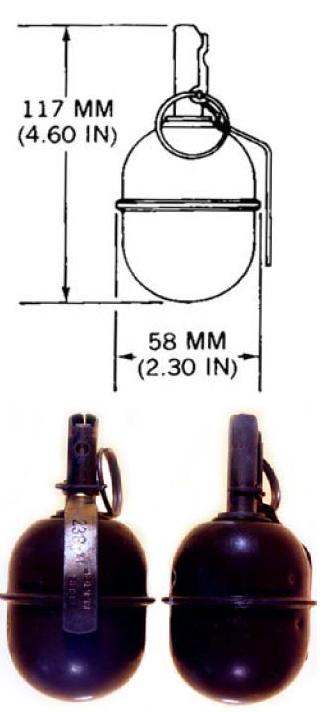INFO ONLY. NOT FOR SALE. P89-4
Type: Hand grenade
Place of origin : Russia
Specifications
Weight: 310 g
Length: 114 mm
Diameter: 56.8 mm
Filling : Trinitrotoluene
Filling weight: 110 g
Detonation mechanism : 4 second pyrotechnic delay fuze

Ruchnaya Granata Degtyareva
("Hand Grenade of the Degtyareva design") This is Soviet RGD-5 developed after WWII
The RGD-5 consists of a two-piece sheet-steel body joined by a circumferential crimp with a hermetically sealed fuze well. An internal fragmentation liner produces about 350 fragments. It is filled with 110g of TNT
This was developed for maximum throwing range. A Russian grenade manual states an average throwing distance of 40-50 meters. Effective casualty radius is 15-20 meters and is hazardous out to about 30 meters. The RGD-5 reflects the modern design trend of maximum fragmentation effect within a limited blast radius. Today, molded plastic bodies and fragmentation matrixes have pretty much replaced cast and sheet metal designs.
Inerted RGD-5 grenades are not common to find as to the difficulties in deactivating them. The body is a sealed unit and must be cut open to remove the filler.
The RGD-5 hand grenade is a post World War II Russian anti-personnel fragmentation grenade. The design dates from the late 1950s. It is still in service in many of Russia's former client states. Additionally, this grenade has been supplied to various foreign countries eg Iraq and other Arab nations. It contains a 110 gram charge of TNT). The total weight of the grenade with the fuze fitted is approximately 310 grams. Typically, the RGD-5 uses the 3.2 to 4 second UZRGM fuze. The UZRGM fuze is a universal Russian type which is also used in the RG-41, RG-42, and F1 grenades. The RGD-5 is sometimes fitted with the more modern DVM-78 fuze, or variants of the UZRGM fuze with delays of between 0 and 13 seconds, for use in booby traps. When an RGD-5 grenade is thrown, it is possible to hear a loud "pop" as the fuze ignites and begins to burn.
The grenade is egg-shaped with no external ribbing, except for a lateral ridge where the two halves of the grenade join. However, the surface of this grenade does have a few small dimples on it. The paint-scheme is generally green or olive drab. The distance the grenade can be thrown is estimated at 40-50 metres. An internal fragmentation liner generates approximately 350 fragments upon detonation. This grenade can inflict injuries (e.g. penetrating eye wounds) out to 15 metres from the site of detonation. Victims caught within 3 metres of the detonation site are almost certain to be killed or severely wounded.
This grenade is still manufactured in Russia. Copies are also produced in Bulgaria, China (as the Type 59), Georgia, and Poland. Millions of RGD-5s and its clones have been manufactured over the years. Though not as advanced as more modern grenades which are specifically designed to penetrate CRISAT standard body armour, the RGD-5 is still an effective and very inexpensive weapon, having the ability to inflict severe injuries to the unprotected limbs of persons wearing kevlar vests. A single RGD-5 grenade costs approximately $5 US, making it very affordable during a major conflict when many grenades are required.
The URG-N is a reusable training model of the RGD-5 of cast iron construction (rather than sheet steel) and a modified fuze containing a compound which simulates the detonation of the grenade.